Prunus serotina (Black Cherry)
| Also known as: | |
|---|---|
| Genus: | Prunus |
| Family: | Rosaceae (Rose) |
| Life cycle: | perennial woody |
| Origin: | native |
| Habitat: | part shade, shade; hardwood forest |
| Bloom season: | May - June |
| Plant height: | 50 to 100 feet |
| Wetland Indicator Status: | GP: FACU MW: FACU NCNE: FACU |
| MN county distribution (click map to enlarge): |  |
| National distribution (click map to enlarge): |  |
Pick an image for a larger view. See the glossary for icon descriptions.
Detailed Information
Flower: 

![[photo of flowers]](/udata/r9ndp23q/pd3/prunus-serotina-001-t.jpg) Numerous nodding, cylindrical racemes 2 to 4½ inches long, at the tips and small lateral shoots of branches, each with 20 to 60 short-stalked flowers. Flowers are about 1/3 inch across with 5 white, round petals, a reddish orange center with a ring of yellow tipped stamens around a single central style. The 5 sepals are 1/3 or less the length of the petals, oblong to triangular, with glands or glandular serrations along the edges. Flower stalks are slender and hairless.
Numerous nodding, cylindrical racemes 2 to 4½ inches long, at the tips and small lateral shoots of branches, each with 20 to 60 short-stalked flowers. Flowers are about 1/3 inch across with 5 white, round petals, a reddish orange center with a ring of yellow tipped stamens around a single central style. The 5 sepals are 1/3 or less the length of the petals, oblong to triangular, with glands or glandular serrations along the edges. Flower stalks are slender and hairless.
Leaves and bark: 

![[photo of leaves]](/udata/r9ndp23q/trees/prunus-serotina-black-cherry-t.jpg) Leaves are simple and alternate, the blade elliptical to somewhat oblong or oval, 2½ to 4½ inches long and to 1 to 2 inches wide, somewhat abruptly tapered to a sharp point, rounded at the base, on a stalk up to about 1 inch long with 1 to several glands near the blade. The upper surface is dark green and shiny, the lower surface lighter and mostly smooth or with hairs along the mid-vein near the base, the hairs white on young leaves becoming rusty colored as they mature. Edges have fine blunt teeth with dark, gland-like tips.
Leaves are simple and alternate, the blade elliptical to somewhat oblong or oval, 2½ to 4½ inches long and to 1 to 2 inches wide, somewhat abruptly tapered to a sharp point, rounded at the base, on a stalk up to about 1 inch long with 1 to several glands near the blade. The upper surface is dark green and shiny, the lower surface lighter and mostly smooth or with hairs along the mid-vein near the base, the hairs white on young leaves becoming rusty colored as they mature. Edges have fine blunt teeth with dark, gland-like tips.
![[photo of twig]](/udata/r9ndp23q/pd3/prunus-serotina-15-9-t.jpg) Twigs are reddish brown to gray, shiny smooth, developing a flaky, waxy cuticle, occasionally a few fleeting hairs are near the base.
Twigs are reddish brown to gray, shiny smooth, developing a flaky, waxy cuticle, occasionally a few fleeting hairs are near the base.
![[photo of bark]](/udata/r9ndp23q/pd3/prunus-serotina-002-t.jpg) Bark is grayish brown, smooth with conspicuous horizontal pores (lenticels), becoming dark gray to black with coarse scaly plates peeling upward around the edges, often described as resembling burnt potato chips. The trunk can typically get up to just over 24 inches in diameter at breast height.
Bark is grayish brown, smooth with conspicuous horizontal pores (lenticels), becoming dark gray to black with coarse scaly plates peeling upward around the edges, often described as resembling burnt potato chips. The trunk can typically get up to just over 24 inches in diameter at breast height.
Fruit: 
![[photo of fruit]](/udata/r9ndp23q/pd3/prunus-serotina-11-t.jpg) Fruit is a shiny, round drupe, dark reddish purple to nearly black, around 1/3 inch in diameter with a single hard seed inside. The sepals typically persist until the stalk drops off.
Fruit is a shiny, round drupe, dark reddish purple to nearly black, around 1/3 inch in diameter with a single hard seed inside. The sepals typically persist until the stalk drops off.
Notes:
Black Cherry is Minnesota largest Prunus species, occupying the canopy throughout Minnesota's central and southeastern forests. Semi shade tolerant it can persist as a small understory tree amongst more open canopies and, in the absence of fire, can establish in open fields and disturbed habitats via the spread of its seeds by birds. It is the second most prized hardwood for cabinetry after black walnut. While it does not sucker heavily from the roots like other native cherries, it is rarely used in the landscape, being considered somewhat weedy and also moderately susceptible to the fungal disease black knot, which can disfigure its shape. A small Black Cherry tree may be confused with Chokecherry (Prunus virginiana), which has similar cylindrical flower clusters but rarely grows taller than 20 feet in Minnesota, has proportionately broader leaves, sepals that wither away as fruit matures, hairs on the leaf underside in the vein axils, and relatively smooth bark that may become furrowed but lacks the peeling plates of Black Cherry.
Native Plant Nurseries, Restoration and Landscaping Services ↓
More photos
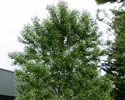 Black Cherry in a home landscape
Black Cherry in a home landscape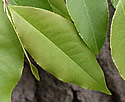 more leaves
more leaves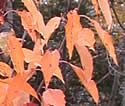 fall color
fall color smooth bark of young tree
smooth bark of young tree scaly bark of old tree
scaly bark of old tree leaves emerging in early spring
leaves emerging in early spring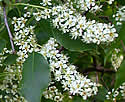 more flowers
more flowers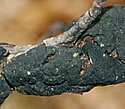 black knot fungus
black knot fungus
Photos courtesy Peter M. Dziuk taken in Anoka and Ramsey counties.
Comments
Have you seen this plant in Minnesota, or have any other comments about it?
on: 2015-07-31 16:53:29
Growing in abandoned pastures and meadows near Rollag, Minnesota. Beautiful color in the fall.
on: 2015-09-13 20:39:00
After reading this I am convinced the tree in my backyard is a black cherry tree and not a chokecherry as I have always thought. It is over 20 years old and is at least 20 feet tall. The birds do not like the fruit. Thank you for the information.
on: 2016-05-30 17:28:43
Is this what some people call pig cherries?? Ripen along with chokecherries but taste bad when raw?
on: 2016-05-30 19:45:19
Karen, maybe you're thinking of pin cherry.
on: 2017-08-03 15:48:31
Who says this is the second most prized hardwood! I prefer figured hard maple to cherry and walnut!
on: 2018-09-24 10:03:50
Just saw two small plants of black cherry on the Munger Trail in Moose Lake. Leaf undersides had distinct rusty hairs at base of midvein
on: 2018-09-30 10:55:55
I saw another black cherry yesterday on the Munger Trail in Barnum which is about 7 or so miles north of Moose Lake where I saw it previously.
on: 2018-11-04 21:45:46
We have these growing in Iowa, in the fields along terraces..
on: 2019-05-04 06:59:25
I found this tree in our woods in sth east Minnesota when I was searching for buckthorn. Many saplings around it...should I remove it? This was the only site I found that showed the emerging leaves which distinguish it from buckthorn.
on: 2019-05-26 08:15:18
We have one of these in our front yard in Vadnais Heights. It is growing as an understory tree and is well over 20ft high. Beware, as we have a Glossy Buckthorn tree, yes that big, growing next to it and the trunks look very similar. The Buckthorn has since been removed,
on: 2019-06-01 23:08:44
We have 3-4 of these blooming at the moment in a small unkept forest on the property. Tallest is probably 30' or so. We have honeybees and they are attracted to the blossoms.
on: 2019-08-08 12:56:53
We have many medium sized Blck Cherry trees in backyard woods.
on: 2019-08-25 09:04:10
We have this tree in our back yard, and this summer the amount of fruit it has produced is amazing; the most in our 12 years living here. Has anyone ever cooked with the fruit?
on: 2020-06-09 12:51:45
Our woods has become full of buckthorn, which we have been pulling out, and I am finding a lot of diversity as well as we remove the buckbrush. I came along this today, and was pleasantly surprised! It is about 20 ft high and maybe 8" at the base.
on: 2020-07-07 20:17:11
I identified a huge cherry tree in my woods this spring when I saw all the cherries.It must be at least 75 years old, because I've lived here 30 years. The cherries are still green. (July 7,2020) Then today if found a bunch of seedlings growing under the tree at the base of another tree. I'm so excited to plant a new grove of cherry trees in the woods.
on: 2020-08-22 15:04:10
I had thought that the tall tree at the back edge of my property looked cherry-like, but then noticed today that it actually had fruit on it. Thanks to the description on this site I got out a ladder and tried one and it definitely is a cherry. I just wish it had more branches within reach!
on: 2021-05-20 16:00:29
The Minneapolis Park Board has planted a bunch of black cherry saplings on a wooded hillside on the southwest end of Lake Harriet. They are protected by white tubes that ate four or five feet tall.
on: 2021-08-25 17:33:31
Planted this tree in my backyard about 20 years ago after purchasing it from a local nursery (back in the days when nurseries had broader varietal inventory than they do today). About five years into its growth, portions of the tree trunk and major branches split open during a winter cold spell. While the splits closed up during the next growing season, portions of the tree died and the branches have been pruned off. It has recovered. Birds strip the tree of its fruit shortly after the fruit forms.
on: 2022-10-02 15:00:51
We noticed this growing in our backyard about 4 feet from a maple tree we had planted. Will they compete or coexist? It does have the red hairs near the base of the leaf and the horizontal stripes on the bark that match the description. Any advice for pruning them? Preventing disease?
on: 2023-05-14 23:52:16
We had a wild cherry in our yard which I believe was Black Cherry. A bird-planted tree that was at the base of a cable supporting a power pole, we have had to have it removed by Xcel Energy because it was designed to interfere with electric wires. I love the color of the bark against the snow and the glossy leaves are attractive. I tried to harvest the fruit, but birds always beat me to it. I now have four small seedlings elsewhere on our property and am wondering if it would be wise or foolish to transplant them to lake home property In Pine County. I have read that they were introduced in mid-20th century by nurseries but can be a nuisance tree. Can create thickets and leaves are toxic to grazing cattle--cyanide. Should I just uproot and toss out those young trees?
on: 2023-06-16 13:17:39
I just planted two very nice sized Prunus serotina on our property in rural Pope County. I have not seen many Black/Rum Cherries here in Pope County, and see that the native range is more to the east. However, being someone who loves and appreciates all flora and fauna, I planted these for my partner and I to enjoy, but also for the local wildlife. I am planning on planting a few Prunus pennsylvanica aka Pin Cherries, as well. I think our native Black/Rum Cherries are beautiful. So are Pin Cherries for that matter. Love the glossy leaves, flowers and bright fruits. Plus, the wood will be probably be valuable at the end of their lives, when we are long gone, since they can live for quite a long time. These are the tree's that cherrywood comes from. It is the cherry that is used in cabinetry and other woodwork.






